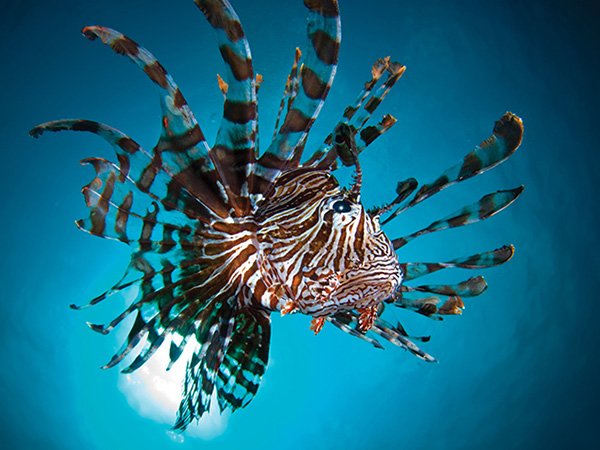The Lionfish’s Fear of Being EatenContents of this Issue: Compass Point, Ocean Frontiers, Grand Cayman Is an Alex Mustard Workshop Right for You? Want to Enroll in an Underwater Photography Course? The Caribbean, Hawaii, the Galapagos, Florida Your Reader Reports are Important Florida Goliath Grouper Protection Battle Lost Do Great Whites Mate off the Carolinas? Save a Reef? Weed it Like You’d Weed a Garden Yucatan Cenotes in Danger of Destruction The Lionfish’s Fear of Being Eaten Lego Reveals the Longevity of Plastic in the Ocean Cancun Dive Boat Propellers Kill Two American Divers Editorial Office: Ben Davison Publisher and Editor Undercurrent 3020 Bridgeway, Suite 102 Sausalito, CA 94965 could the groupers’ appetite be crucial? from the March, 2022 issue of Undercurrent
The fish stared at me, and I stared right back, taking in its tiger-like red and white stripes, its flamboyant, fan-like pectoral fins, and the row of venomous, upright spines along its back. Thin pieces of its flesh swayed ominously on the spikes in the ocean currents.
The lionfish is a striking creature. There is no wonder why it is a popular fish in the aquarium trade. But the lionfish is also infamous, at the center of one of the most well documented and concerning marine fish invasions in history. Large individuals are often bold and will position themselves in a head-down, menacing posture with flaring fins and swaying spines, toward any potential threat, including divers like me. I was on a reef off Eleuthera Island in the Bahamas, where I was studying the interactions between native predatory fishes and invasive lionfish. The lionfish has few natural predators, and its venomous spines pose a major problem for marine managers because they deter potential predators that could naturally control the growth of this invader's population. I hoped my research might show that at least some predators in the Bahamas could challenge the successful takeover of reefs by lionfish.
Atlantic under invasion Lionfish - a general term often used to describe two species, Pterois volitans and P. miles - are native to the Indian and Pacific oceans where they are mid-level predators on coral reefs, feeding on a variety of crustaceans and small fishes. But they are now invading the western Atlantic Ocean, from North Carolina to Brazil. Lionfish were introduced in the mid-1980s off the coast of Florida, where they escaped from home aquariums or were intentionally released. Now spread out along much of the American Atlantic coast, these efficient predators have decimated native fish populations on some Caribbean reefs by an average of 65 percent. And it doesn't stop there. Lionfish are also now invading parts of the eastern Mediterranean. Among its prey are young commercially valuable species like snappers and grunts, meaning lionfish could have a negative impact on reef fisheries in the medium- to long-term. It also eats the critically endangered social wrasse, found only in Belize. It has even consumed substantial numbers of a fish species new to science. They also pose a bit of a problem for recreational dive tourism. When lionfish numbers grow and native fishes decrease, the aesthetic value of coral reefs can drop. One study found that inexperienced divers preferred seeing lionfish on reefs, but more experienced divers, who also tend to spend more money diving, did not.
Protecting groupers In 2008, a study found Caribbean groupers, a common and widespread group of medium- to-large-sized coral reef fishes, were eating lionfish in the Bahamas. This early evidence gave everyone in the region hope that groupers might be a natural, cheap, and relatively easy solution to reducing lionfish numbers and curbing their negative impacts on native fish. One would only have to protect the groupers and let nature do its thing. It seemed far more financially feasible and ecologically effective than other strategies like culling, which involves divers plucking lionfish from reefs one by one using pole spears and nets. It would also involve less work than persuading people to fish and consume lionfish through a commercial fishery. Later studies, however, produced conflicting evidence. One small-scale, observational study in a marine protected area in the Bahamas showed that lionfish abundances tended to decline with increasing abundances of native groupers. Yet a larger study involving three eco-regions within the Caribbean found no relationship between lionfish and grouper abundances. Both studies searched for correlations between grouper and lionfish abundances in the Caribbean, and both lacked experimental field work. Until now. The power of fear In a field experiment on coral reef patches around Eleuthera Island, the Bahamas, Isabelle Côté, a professor of marine ecology at Simon Fraser University, and I investigated whether groupers might limit the success of lionfish in more subtle ways. Perhaps the fear of being eaten (called fear effects) or competition for food from similarly sized groupers would limit lionfish survival or their negative impacts on native species. Fear effects are common in nature. They occur when prey alter their behaviors in ways that make it difficult for predators to encounter, detect or capture them - but sometimes at a cost. Although lionfish are typically bold toward other fishes (and human divers), large groupers may evoke fear in smaller lionfish. This might then lead to behavioral changes that make it more difficult for groupers to eat lionfish, but that also disadvantage the lionfish in a way that is beneficial to native species. We found that small lionfish were more likely to hide at dawn - peak feeding hours - on reefs with high numbers of large groupers. Usually, both groupers and lionfish take advantage of the low light to hunt, but if lionfish are hiding when they should be hunting, they eat less - good news for the native fish. Lionfish were also less active during the day on reefs with increasing grouper predator densities. If a lionfish wants a quick snack of unsuspecting prey during daylight hours, it is less likely to do so if it is inactive. Lionfish can't eat if they're hiding or inactive, and less food can lead to reduced body growth in reef fish. Swamped by yellow grunts Unfortunately, we didn't see a change in the abundance of native fish in our study. This might have been due to bad timing. When we went to measure them, the reefs were flooded with hundreds of small yellow grunts following a major summer recruitment event, when young fish settle out of the water column onto reefs. Any effect that reduced lionfish foraging may have had on prey fishes could have been swamped by this excess of available food. So where does this leave us? Large groupers may play a role in reducing lionfish foraging success, but it is unclear whether this effect has any bearing on native prey populations or on lionfish traits that may increase its ability to survive or reproduce, like body size. Groupers are heavily fished throughout the Caribbean. If they are to have an effect on the lionfish invasion, governments may need to impose stricter regulations that protect more than just one species of grouper.
The author, Nicola Smith, PhD., is a postdoctoral research fellow at Simon Fraser University, BC, Canada. First published in The Conversation and licensed to reproduce. https://tinyurl.com/2hcu2a78 |

I want to get all the stories! Tell me how I can become an Undercurrent Online Member and get online access to all the articles of Undercurrent as well as thousands of first hand reports on dive operations world-wide
| Home | Online Members Area | My Account |
Login
|
Join
|
| Travel Index |
Dive Resort & Liveaboard Reviews
|
Featured Reports
|
Recent
Issues
|
Back Issues
|
|
Dive Gear
Index
|
Health/Safety Index
|
Environment & Misc.
Index
|
Seasonal Planner
|
Blogs
|
Free Articles
|
Book Picks
|
News
|
|
Special Offers
|
RSS
|
FAQ
|
About Us
|
Contact Us
|
Links
|
3020 Bridgeway, Ste 102, Sausalito, Ca 94965
All rights reserved.


 Groupers may not be the silver bullet that saves coral reefs. Other, potentially more difficult, invasion management strategies like culling, lionfish tournaments, and promoting a commercial lionfishery, may all be required. We may need to throw everything at this problem.
Groupers may not be the silver bullet that saves coral reefs. Other, potentially more difficult, invasion management strategies like culling, lionfish tournaments, and promoting a commercial lionfishery, may all be required. We may need to throw everything at this problem.